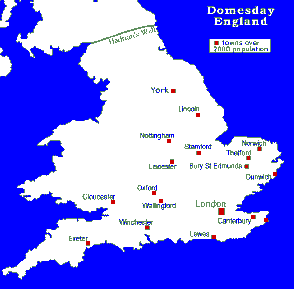The best site for medieval towns or villages
At the time the Domesday Book was compiled in 1087, there were only 18 towns in England with a population of over 2000. Many of these medieval towns were originally Roman towns. But what if you want to establish a new town or village. What things do you have to consider when choosing a site?
Castles
It might be a good idea to position your new town or village near an existing castle. Castles are built for defence and contain knights and soldiers trained in weapons. This would give you good protection against raiders and invaders. Merchants also trade goods with castles and you might be able to trade with them as well. This will help to make your town richer and will attract more people to live there.
High Ground
If there is not a castle nearby then it might be a good idea to position part of your new town or village on some high ground. You would then have a good view of the surrounding area and be able to spot possible attackers in plenty of time to prepare your own defence.
Water
You think you have found the perfect spot for medieval towns, but is there a water supply nearby? Remember, there is no running water. Water has to be fetched each day from a river or stream and your people do not want to have to walk miles for it. A wide stream or river will also help to defend your town as attackers will have to find some way to cross it.
Stone
You have found a site with high ground that is near a stream. Your people will want to build themselves somewhere to live. Stone is the best building material for medieval towns as it offers the best protection against both attack and the weather. Having a good supply of stone will also allow you to build a wall around your town for added protection. Stone is also useful for throwing at your attackers and for making weapons.
Wood
Much of Britain in the medieval period was covered with forest so it should not be too difficult to find a site with a good supply of wood nearby. If there is not a lot of stone your people can make themselves houses from wood. You also need wood to make handles for axes and spears. But the most important thing about wood is that it is needed for making fires. A fire is essential for cooking, heating and for scaring off wild animals.
Food
You have positioned your new town or village near a stream so there should be a good supply of fish. However, your people will not want to eat fish all the time and it is against the religion to eat fish at certain times of the year. You can send hunters out into the forest to catch meat, but you need to grow crops and vegetables as well. It is therefore important that there is some land that can be used for farming.
Planning and designing medieval towns, as we have seen, is a laborious effort.
This article is part of our larger selection of posts about the medieval period. To learn more, click here for our comprehensive guide to the Middle Ages.
This article is also part of our larger selection of posts about Medieval Life. To learn more, click here for our comprehensive guide to Medieval Life.
Cite This Article
"Medieval Towns and Villages" History on the Net© 2000-2024, Salem Media.
May 19, 2024 <https://www.historyonthenet.com/medieval-towns-and-villages>
More Citation Information.
